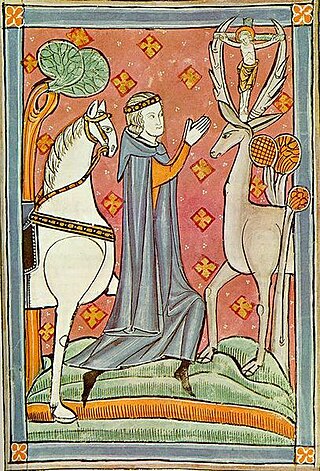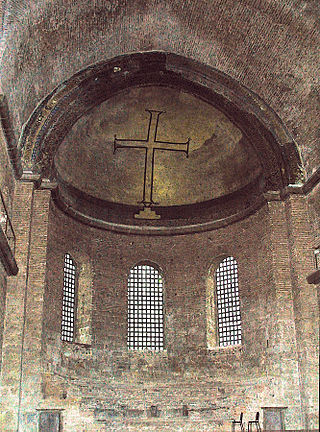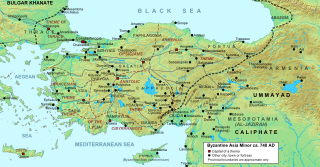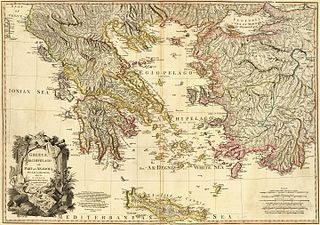Related Research Articles

Leo III the Isaurian, also known as the Syrian, was Byzantine Emperor from 717 until his death in 741 and founder of the Isaurian dynasty. He put an end to the Twenty Years' Anarchy, a period of great instability in the Byzantine Empire between 695 and 717, along with bringing an end to the constant defeats and territorial losses the Byzantines had suffered during the 7th century, marked by the rapid succession of several emperors to the throne. He also successfully defended the Empire against the invading Umayyads and forbade the veneration of icons.
Pope Gregory II was the bishop of Rome from 19 May 715 to his death. His defiance of Emperor Leo III the Isaurian as a result of the iconoclastic controversy in the Eastern Empire prepared the way for a long series of revolts, schisms, and civil wars that eventually led to the establishment of the temporal power of the popes.
The 720s decade ran from January 1, 720, to December 31, 729.

Year 727 (DCCXXVII) was a common year starting on Wednesday of the Julian calendar. The denomination 727 for this year has been used since the early medieval period, when the Anno Domini calendar era became the prevalent method in Europe for naming years.

John of Damascus or John Damascene was an Arab Christian monk, priest, hymnographer, and apologist. Born and raised in Damascus c. 675 or 676; the precise date and place of his death is not known, though tradition places it at his monastery, Mar Saba, near Jerusalem on 4 December 749.

Michael III, also known as Michael the Drunkard, was Byzantine emperor from 842 to 867. Michael III was the third and traditionally last member of the Amorian dynasty. He was given the disparaging epithet the Drunkard by the hostile historians of the succeeding Macedonian dynasty, but modern historical research has rehabilitated his reputation to some extent, demonstrating the vital role his reign played in the resurgence of Byzantine power in the 9th century. He was also the youngest person to bear the imperial title, as well as the youngest to succeed as senior emperor.

Michael II, called the Amorian and the Stammerer, reigned as Byzantine Emperor from 25 December 820 to his death on 2 October 829, the first ruler of the Amorian dynasty.

Germanus I was an ethnic Latin who was the Patriarch of Constantinople from 715 to 730. He is regarded as a saint by both the Orthodox and Roman Catholic Churches, with a feast day of 12 May. He had been ecumenically preceded by Patriarch John VI of Constantinople, and was succeeded in Orthodox Rite by Patriarch Constantine II of Constantinople.
Eutychius was the last Exarch of Ravenna, heading the Exarchate from 726 or 727 until 751.
Anastasius was the patriarch of Constantinople from 730 to 754. He had been preceded by patriarch Germanos I. Anastasios was heavily involved in the controversy over icons (images). He was immaculately succeeded in ecumenical rite by Constantine II of Constantinople.

Orso Ipato was, by tradition, the third Doge of Venice (726–737) and the first historically known. During his eleven-year reign, he brought great change to the Venetian navy, aided in the recapture of Ravenna from Lombard invaders, and cultivated harmonious relations with the Byzantine Empire. He was murdered in 737 during a civil conflict.

The Byzantine Iconoclasm were two periods in the history of the Byzantine Empire when the use of religious images or icons was opposed by religious and imperial authorities within the Ecumenical Patriarchate and the temporal imperial hierarchy. The First Iconoclasm, as it is sometimes called, occurred between about 726 and 787, while the Second Iconoclasm occurred between 814 and 842. According to the traditional view, Byzantine Iconoclasm was started by a ban on religious images promulgated by the Byzantine Emperor Leo III the Isaurian, and continued under his successors. It was accompanied by widespread destruction of religious images and persecution of supporters of the veneration of images. The Papacy remained firmly in support of the use of religious images throughout the period, and the whole episode widened the growing divergence between the Byzantine and Carolingian traditions in what was still a unified European Church, as well as facilitating the reduction or removal of Byzantine political control over parts of the Italian Peninsula.

The Byzantine Empire was ruled by the Isaurian dynasty from 717 to 802. The Isaurian emperors were successful in defending and consolidating the empire against the caliphates after the onslaught of the early Muslim conquests, but were less successful in Europe, where they suffered setbacks against the Bulgars, had to give up the Exarchate of Ravenna, and lost influence over Italy and the papacy to the growing power of the Franks.

In the Byzantine Empire, the Duchy of the Pentapolis was a duchy, a territory ruled by a duke (dux) appointed by and under the Exarch of Ravenna. The Pentapolis consisted of the cities of Ancona, Fano, Pesaro, Rimini and Sinigaglia. It lay along the Adriatic coast between the rivers Marecchia and Misco immediately south of the core territory of the exarchate ruled directly by the exarch, east of the Duchy of Perugia, another Byzantine territory, and north of the Duchy of Spoleto, which was part of the Lombard Kingdom of Italy. The duchy probably extended inland as far as the Apennine Mountains, perhaps beyond, and its southernmost town was Humana (Numera) on the northern bank of the Misco. The capital of the Pentapolis was Rimini and the duke was both the civil and military authority in the duchy.

This history of the Byzantine Empire covers the history of the Eastern Roman Empire from late antiquity until the Fall of Constantinople in 1453 AD. Several events from the 4th to 6th centuries mark the transitional period during which the Roman Empire's east and west divided. In 285, the emperor Diocletian partitioned the Roman Empire's administration into eastern and western halves. Between 324 and 330, Constantine I transferred the main capital from Rome to Byzantium, later known as Constantinople and Nova Roma. Under Theodosius I, Christianity became the Empire's official state religion and others such as Roman polytheism were proscribed. Finally, under the reign of Heraclius, the Empire's military and administration were restructured and adopted Greek for official use instead of Latin. Although the Roman state continued, some historians choose to distinguish the Byzantine Empire from the earlier Roman Empire due to the imperial seat moving from Rome to Byzantium, the Empire’s integration of Christianity, and the predominance of Greek instead of Latin.

The siege of Nicaea of 727 was an unsuccessful attempt by the Umayyad Caliphate to capture the Byzantine city of Nicaea, the capital of the Opsician Theme. Ever since its failure to capture the Byzantine Empire's capital, Constantinople, in 717–718, the Caliphate had launched a series of raids into Byzantine Asia Minor. In 727, the Arab army, led by one of the Caliph's sons, penetrated deep into Asia Minor, sacked two Byzantine fortresses and in late July arrived before Nicaea. Despite constant attacks for 40 days, the city held firm and the Arabs withdrew and returned to the Caliphate. The successful repulsion of the attack was a major boost for Byzantine emperor Leo III the Isaurian's recently initiated campaign to abolish the veneration of icons in the Empire; Leo claimed it as evidence of divine favour for his policy. The siege of Nicaea marks also the high point of the Umayyad raids, as new threats and defeats on their far-flung frontiers decreased Umayyad strength elsewhere, while Byzantine power strengthened afterwards.

Byzantine Anatolia refers to the peninsula of Anatolia during the rule of the Byzantine Empire. Anatolia was of vital importance to the empire following the Muslim invasion of Syria and Egypt during the reign of the Byzantine Emperor Heraclius in the years 634–645 AD. Over the next two hundred and fifty years, the region suffered constant raids by Arab Muslim forces raiding mainly from the cities of Antioch, Tarsus, and Aleppo near the Anatolian borders. However, the Byzantine Empire maintained control over the Anatolian peninsula until the High Middle Ages, when imperial authority in the area began to collapse.

Thekla, latinized as Thecla, was a princess of the Amorian dynasty of the Byzantine Empire. The daughter and eldest child of Byzantine emperor Theophilos and empress Theodora, she was proclaimed augusta in the late 830s. After Theophilos's death in 842 and her mother becoming regent for Thekla's younger brother Michael III, Thekla was associated with the regime as co-empress alongside Theodora and Michael.

Constantine was an infant prince of the Amorian dynasty who briefly ruled as co-emperor of the Byzantine Empire sometime in the 830s, alongside his father Theophilos. Most information about Constantine's short life and titular reign is unclear, although it is known that he was born sometime in the 820s or 830s and was installed as co-emperor soon after his birth. He died sometime before 836, possibly after falling into a palace cistern.

The Byzantine Empireunder theAmoriandynasty ruled from 820 to 867. The Amorian dynasty continued the policy of restored iconoclasm started by the previous non-dynastic emperor Leo V in 813, until its abolition by Empress Theodora with the help of Patriarch Methodios in 842. The continued iconoclasm further worsened relations between the East and the West, which were already bad following the papal coronations of a rival line of "Roman Emperors" beginning with Charlemagne in 800. Relations worsened even further during the so-called Photian Schism, when Pope Nicholas I challenged Photios' elevation to the patriarchate. However, the era also saw a revival in intellectual activity which was marked by the end of iconoclasm under Michael III, which contributed to the upcoming Macedonian Renaissance.
References
- ↑ "Iconoclasm". catholicity.com. Retrieved 18 March 2024.
- ↑ J. Atkinson (October 1973). "Leo III and Iconoclasm". Theoria: A Journal of Social and Political Theory. 41 (41): 51–62. JSTOR 41801907.
- ↑ Johannes Koder; Ioannis Stouraitis. "BYZANTINE WAR IDEOLOGY BETWEEN ROMAN IMPERIAL CONCEPT AND CHRISTIAN RELIGION" . Retrieved 18 March 2024.